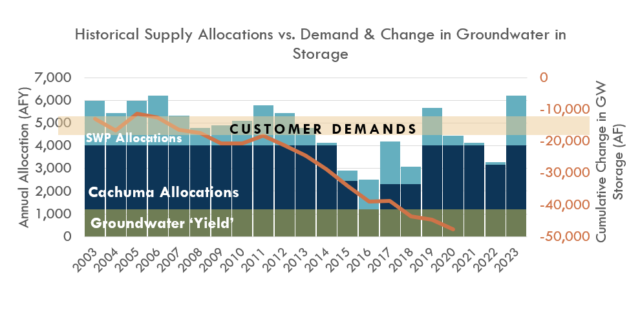The Value of a Locally Managed Purified Water Supply in Carpinteria – CVN Article, May 16, 2024
Written by: Robert McDonald, General Manager of Carpinteria Valley Water District
After two wet years, it may not be obvious to some why there is still a pressing need to develop a new water supply here in Carpinteria. The advanced water purification facility (AWPF) that is currently under design, which has already been awarded $15.8M in grants, is a part of the Carpinteria Advanced Purification Project (CAPP). CAPP, an indirect potable reuse project, will take water that has already been cleaned at the Carpinteria Sanitary District (CSD) facility, purify it in a newly constructed AWPF, and then store the purified water in the Carpinteria Groundwater Basin for later potable use. CAPP adds more than 300 million gallons of clean drinking water to the community per year.
The Carpinteria Valley Water District’s (CVWD’s) current sources of water are facing increased environmental and regulatory pressures. The Carpinteria Valley experienced the lowest supply availability since its inception recently. Due to these pressures, climate change, and planned regulations, supplies are projected to decrease further. It is important for the community to develop a supply that is not subject to outside influences that decrease the amount of water available in the future. In addition, it is critical to develop a water source that is resilient against climate change and the inconsistent rainfall that we experience here in Santa Barbara County and the rest of the State.
Currently, the Carpinteria Valley depends on water from a mixture of surface water and local groundwater supplies. (An overview of how the availability of these various water supply sources have declined due to environmental and regulatory pressures during the last 20 years is presented in Figure 1.)
Surface water consists of the following:
1. The State Water Project
2. Water from Lake Cachuma.
Let’s begin — the State Water Project allocations are highly unpredictable and variable. Water passes through a lengthy conveyance system to reach us from northern California. This system of aqueducts and pipes is susceptible to natural disasters such as earthquakes. For this reason, it’s possible we could become completely disconnected from this water source in the future. We cannot continue to depend upon water traveling across the state.
That brings us to our only other source of surface water — Lake Cachuma. The amount of water that we have received from Lake Cachuma has been inconsistent, and reservoir levels were reduced to a mere 7% of its total capacity as recently as Fall of 2016. No water from Lake Cachuma was delivered to Carpinteria Water that year. Frequent and long-term droughts are cause for obvious concern. Additionally, Lake Cachuma water is closely regulated due to the endangered steelhead trout occupying the Santa Ynez River and its tributaries. Cachuma water must be released to maintain critical steelhead habitat and increase the spawning potential of the river system.

Figure 1. Historical Water Supply Availability versus Customer Demand and Change in Groundwater Storage
This leaves our only groundwater source — the Carpinteria Groundwater Basin (Basin). Without CAPP, the Basin can provide a long-term average sustainable yield of around 1,200 acre-feet (af), or 390 million gallons, of water per year. With CAPP, we will nearly double how much groundwater we can pump without adversely impacting the long-term health of the Basin.
We depended upon groundwater during the last drought-period when surface water supplies dwindled or were unavailable. Because this water source was relied upon so heavily by both CVWD and private pumpers in recent years, water in storage has declined significantly. That means this water supply will be less available until water levels in the Basin recover. The line displaying a startling downward trend overlying the annual water supply data in Figure 1 is the estimated cumulative change in groundwater storage in the Basin. In 2018, the Basin was designated as a high-priority groundwater basin by the California Department of Water Resources as a part of enforcing the Sustainable Groundwater Management Act. The designation of a high-priority groundwater basin is reserved for those basins that are essential for providing drinking water and supporting agricultural operations, and are at risk of unsustainable conditions due to excessive consumption.
It is evident that our groundwater storage has drastically decreased, and it is important to reduce strain on this important resource. CAPP will help to increase groundwater levels and supplement naturally-occurring groundwater recharge since purified water will be injected into the Basin for storage and later use.
By developing CAPP, the Carpinteria Valley will be prepared for future droughts and will be able to survive them when faced with minimal surface water supplies. This new water source will increase our climate change resiliency and allow for adaptability as environmental and regulatory pressures impact our other water resources. We cannot let two wet winters distract us from the extreme value that CAPP will provide to our community and to future generations in Carpinteria – CAPP will prepare Carpinteria to thrive during the next extended drought, replenish the groundwater basin, and increase local control over CVWD supplies.
As we continue to make forward strides on CAPP, we encourage you to explore the CAPP website at cvwd.net/capp and sign up for updates. You can also follow CVWD on Twitter @CarpWater, or Carpinteria Valley Water District on Facebook and Nextdoor.
